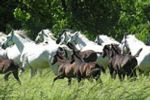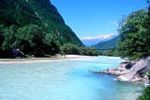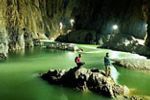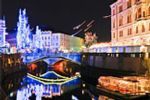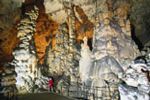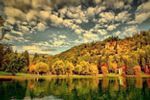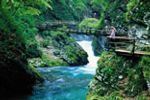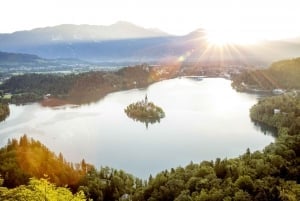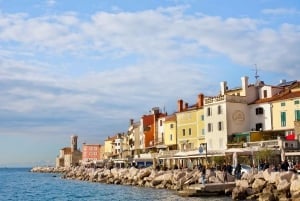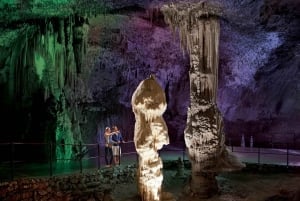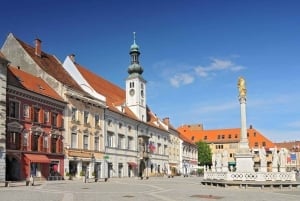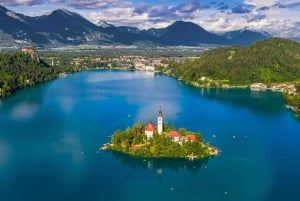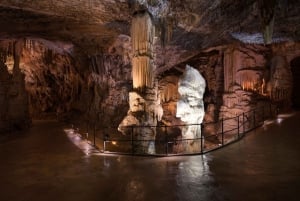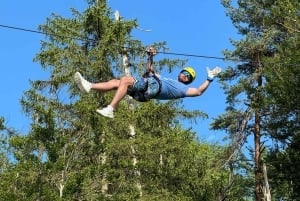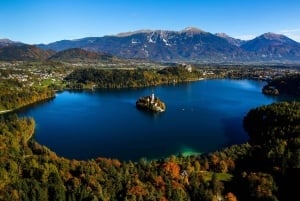Slovenia Attractions
1. Ljubljana
Ljubljana, the capital of Slovenia, is the administrative, political, cultural, economic and traffic centre of the country. The city has all the characteristics of modern and highly developed country centres, but has still maintained the kindness and ease of a small town. Through the centuries Ljubljana developed and expanded under the castle hill on the left and right bank of Ljubljanica river. The oldest marks of settlement in this area are from the Bronze Age. On these prehistoric foundations the Roman town Emona was built, which represented the most favourable crossing from the Apennine Peninsula towards the North. In the 6th century ... Read more about Ljubljana
2. Postojna Cave
Postojna Cave, now in its second century of attracting throngs of admirers from all over the world, was also a challenge for the bold explorers of the underworld who, with patience and perseverance, penetrated ever deeper underground. The visitor's curiosity is satisfied by facts about the formation of caves, a guided visit through passages and chambers and, above all, by observing the stalactites hanging from the ceiling, the stalagmites growing up from the floor, the pillars formed when stalactites and stalagmites meet, the folds of calcite curtains and the other sequences of fantastic shapes and forms... Read more about Postojna Cave
3. Bled
The north-west, Alpine part of Slovenia is represented by the most developed region Upper Carniola. The symbol of the Upper Carniola is certainly Lake Bled. Surrounded by steep hills it creates an idyllic mountain spot. In summer it is a place to swim and lie in the sun, and in winter a place to relax after tiring skiing. All year long you can choose from a variety of sport activities, and all those who would like to get your special wish come true can go to the island and ring the bell of wishes in the church! Above the lake rises the three-peaked Triglav, the highest mountain in Slovenia. We are... Read more about Bled
4. Lipica
In the picturesque Karst region of Slovenia, in the heart of a green oasis under the azure Mediterranean sky, in the shade of century-old lime trees and oaks, and just a stone's throw from the Slovenian–Italian border lies the Lipica Stud Farm – the cradle of the Lipizzaner horse. The stud farm was founded in 1580 and, today, it is a jewel among the cultural and historical monuments of the Republic of Slovenia. For over four centuries, the Lipica Stud Farm has nurtured the tradition of breeding and selecting thoroughbred horses. In the period after World War II Lipica established its own classical riding school and has successfully performed with its horses at various equestrian events all over the world. Today, Lipica is a world famous recreational centre with a hint of tradition, offering its... Read more about Lipica
5. Škocjan Caves
The Škocjan Caves are a unique natural phenomenon, the creation of the Reka River. The Reka River springs from below the Snežnik plateau and flows some fifty-five kilometres on the surface. After reaching the Karst, that is the limestone surface, the river not only deepens its riverbed through erosion, but also by means of corrosion – it dissolves the limestone. In the first part of its course on the limestone, the Reka still flows on the surface, along an approximately four-kilometre-long gorge that ends with a magnificent wall under which it disappears underground. The Reka River blind valley is the largest in Slovenia. In the distant past, probably in the Early Pleistocene, that is a few hundred thousand years ago, the ceiling of the cave collapsed some 200 metres from the sinks; as a result, the collapse dolines Velika dolina (up to 165 metres deep) and Mala dolina (120 metres)... Read more about the Škocjan Caves
6. Triglav National Park
The Triglav National Park (TNP) is the only Slovenian national park. The park was named after Triglav, the highest mountain in the heart of the park, which is also the highest summit in Slovenia (2864 m). The origin of the name Triglav is rather uncertain. Triglav (»three-headed«) owes its name to its characteristic shape as seen from the south-east side or to the highest Slavic deity who was supposed to have its throne on the top of the mountain. The mountain is a true national symbol and is featured on the national coat of arms and the flag. The Triglav National Park extends along the Italian border and close to the Austrian... Read more about Triglav National Park
7. Vintgar Gorge
The Vintgar gorge is one of the most popular natural features in Slovenia. The gorge has been arranged for visitors for more than a hundred years. Along the narrow passage, where the Radovna river thrashes loudly against its rocky confines, there are paths, galleries and bridges constructed in the rock. The trail runs through the 1600 m long gorge. The Radovna flows over cascades and rapids, and in clear pools it finds peace for a few moments. The Vintgar gorge ends at the delightful Šum waterfall, the highest river fall in Slovenia. At the waterfall the trail leaves the Radovna and rises up a track heading south-east to the chapel of St Catherine above Zasip. From here there is one of the finest views over the entire area of Bled. The way back goes down to Zasip and then... Read more about Vintgar Gorge
8. Piran
The Primorska region is an area of various surprises. Beside the coastal towns it is enriched by the natural beauties and rock settlements in the interior, which are impressed in the memory of everyone who visits them. The picturesque coastal town of Piran, which is so archaic and Mediterranean that it attracts more and more curious people. This is the feeling you get while walking the narrow streets among the closely joint houses which climb up like stairs towards the top of the ridge. Piran developed as an old harbour and fishing town built in the Middle Ages, and is completely protected as a cultural and historical monument. Today the town is a touristic site with many hotels, restaurants, museums and a beautiful aquarium... Read more about Piran
9. Logar valley
This trough-like valley was created by the play of the nature deep in the heart of the Kamnik-Savinja Alps, enshrouded by the lofty peaks all of which rise above 2,000 metres. A tranquil walk in the valley and the surrounding area reminds us of the centuries-old harmony here between men and nature. The foundations of the picturesque Alpine valley one can enjoy today were in fact laid down during the last Ice Age when a huge glacier abraded a 7-km long, 250-m wide U shaped basin. The valley is divided into three parts: the lower tract is called Log, the central one Plest, whilst the upper part is known as Kot. Log and Plest are covered by meadows, whilst Kot is partially forested... Read more about Logar Valley
10. Tolmin gorges and Trenta valley
One of the most famous, outstanding and gorgeous natural feature in Slovenia is indeed Tolmin gorge with Tolminka river. The junction of the gorges of the Tolminka and Zadlašcica rivers with their chutes is a unique phenomenon in Slovenia. The chute of the Tolminka River is about two hundred meters long and five to ten meters wide. The spring of thermal water on the bank of the Tolminka just below the end of the trail through the chute is another great rarity in the alpine world. The well known Hudicev most ('Devil's Bridge') over which the Tolmin-Cadrg road passes arches sixty meters above the Tolminka, and above it is the entrance to the Zadlaška or Dante Cave. A triangular rock called the Medvedova glava... Read more about Tolmin Gorges and Trenta Valley
Find out more – connect with us on Facebook!


